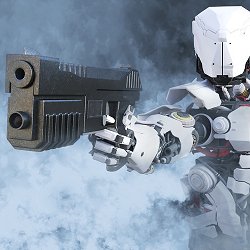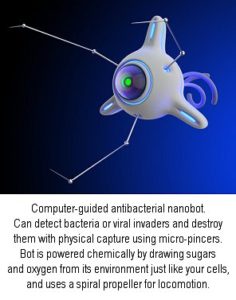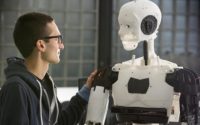Why Synthetic Doom?
 Synthetic doom? Really? Is that what’s about to happen to us?
Synthetic doom? Really? Is that what’s about to happen to us?
Yes, I’ll admit ‘Synthetic Doom’ is a rather dramatic name for this new short-book series which takes a critical look at both the staggering potential AND the troubling downside to the rapid technological changes zooming at us from all directions.
It is a name, however, that I think rings just enough of an alarm to get people’s attention, and that’s why I like it. There is no question that already, early on in the 21st century, we are plunging forward into a very unique and highly unpredictable epoch in human history. We stand astride an uncertain social and technological tipping point where our ability to manipulate matter — in the guise of several new mega-technologies — has reached a threshold where they could very well produce wonders unimagined, OR unleash hellish nightmare scenarios.
I’m sure you’re familiar with, or at least have heard of, most of the usual doomsday imaginings regarding cutting-edge technologies such as robotics, artificial intelligence, nanotech and genetic engineering. All seem poised to deliver utopian wonders or apocalyptic terrors without a clue at this time as to where the better odds might lie.
There are already 9 million robots in the world, and they are — not just expanding in their absolute numbers rapidly — but in sophistication and capability, what engineers refer to as “robustness”. It won’t be long before they begin flowing out of the labs and into everyday life in hundreds of different manifestations, from nursebots to self-driving cars.
Already 3 million of these robots are laboring away in industrial production tasks as you read this (day or night, doesn’t matter). Synthetics are going to pose a serious economic threat in the coming decades as they begin disemploying legions of humans in thousands of different ways… from both the bottom, middle and eventually even the TOP of the employment ladder. Apocalyptic popular fiction is about to become a very uncomfortable reality before the end of this century I fear.
Beyond the many dangers of becoming over-reliant on pure automation, one of the most shocking yet worrisome advancements that is about to happen sooner than we will probably be ready for it, is human augmentation. Augmentation of ordinary people with technologic prosthetics will begin with devices that are essentially an improvement over the Google glasses/VR type of virtual reality systems, and progress rapidly from there as the hardware interfaces become more socially acceptable (like, for instance, smartphones).
Virtual reality is currently more like a Pokeman Go-type immersive game than the “real” reality of true augmentation — where information-bearing avatars and/or relevant data is overlaid atop the actual visual environment surrounding you, whatever that may be. This will be accomplished using micro lasers projecting data and images directly onto your retina. Such devices will probably become less and less obtrusive (and surely less expensive) as they are adopted widely, and could even be built into jewelry, our clothing and eventually worn under the skin inside our bodies.
And so, we will have taken our first step towards the physical melding of ourselves into our machines.
I believe augmentation is destined to become merely the first step in a self-guided, highly accelerated “next phase” of human evolution. We are teeing ourselves up to become a whole new species. Homo Sapiens will deliberately evolve themselves up the intelligence ladder towards Homo Machina — “machine man”.
We will no longer be bound by the limitations of the biological proteins that brought us into existence, but will finally begin to transcend them. Microseconds (1/thousandths) of organic brain response time will transform into nanoseconds (1/billionths) once enhanced and our ability to calculate and visualize will take a quantum leap. Augmentation of the human mind with the aid of electronic-based systems has already begun. You may not think much about it, but if you have a smartphone in your pocket and an Internet connection available, then your brain has all the information on Google and Wikipedia (just to name a few) at its beck and call whenever you may require it. Instant memory, knowledge and recall.
For all practical purposes, yourself and those information prosthetics are the same consciousness… the same mutual Mind!
Seriously, this is no joke: all of those countless terabytes of information in the cloud are actually an extension of your brain, and are as useful to your intelligence as anything that you have ever learned, memorized and stored in your organic brain “the old fashioned way”. Instantly accessing all this information makes you thousands, perhaps even MILLIONS, of times smarter than the average person walking down the street even 15 or 20 years ago — someone who did not have access to such fantastic technology as you do, and which is already commonly taken for granted.
Information is information — what’s the difference where it’s stored as long as it’s immediately accessible to your mind whenever you need it?
And look, it is not “cheating” to use Google or to look something up on Wikipedia when you need to know it. No more than it is “cheating” to employ your right frontal lobe when you are thinking about a problem. You are free (and hell, even encouraged!…) to engage every brain cell in your head in order to generate rational cognition and generate useful solutions, are you not? The application of these (for now, primitive) brain extensions is no different than doing what we’ve always done as humans: used our ever-increasing intelligence to survive and thrive.
So if the movement towards artificial intelligence and human augmentation has already begun, then what must lie ahead in the coming decades? It will all depend on how rapidly three unique but interwoven technologies advance: robotics/AI, genetic engineering, and nanotechnology. Each one of these doctrines promises a fantastic world of economic equality, security and widespread human contentment. Unfortunately, they can all be easily abused and maliciously twisted to unleash horrors upon us. And even more unfortunately, there are legions of bad actors in this world who can’t wait to get their hands on these technologies and turn them to the dark side. Militaries around the world are already at work in paranoid secret laboratories for sure, so this process is almost certainly underway right now, and without any real oversight.
AI will also work to advance new breakthroughs and oversee engineering marvels in those other two fields as well: genetic engineering and nanotechnology. These two sciences are actually closely related, as they both deal with microscopic-sized engineering that can’t be seen by the naked eye.
All living things including you and I have been built (and continue to be self-repaired) by nano-machines. That’s exactly what living cells working within the bounds of chemistry, DNA and RNA actually are — they are nanobots. The goal of nanotech science is to create guided, functional devices on this kind of molecular scale. These machines would literally be able to go inside your cells and repair things simply by moving atoms and molecules around and re-stitching them into different configurations. Sort of like intelligently directed “tinker-toy” chemistry, performed on a microscopic level with tiny mechanical machines.
You can easily see the enormous amount of variation and types of functions that organic matter can manifest and perform, all based on atomic manipulations and the widespread generation of thousands of different unique proteins on a molecular level. Organic machinery runs strictly by a chemical code that it reads from DNA, but “Nanites” could conceivably be directed by a wireless external controller that would steer them where to go, what to do and how to analyze whatever data they might send back about the current condition of the cells and molecules they are working on. Afterwards they would exit the target cells with little or no damage and collect themselves into your colon for disposal
You can readily see how the ability to insert itself directly into your cells in such a precise way has within it both a promise of great medical wonders as well as medical horrors… a biological warfare type calamity just waiting to happen. I’m sure you’ve already heard about the so-called “grey goo” threat of nano technology — nanites self-replicating wildly out of control. Uninhibited auto-replication is THE biggest danger of nanobots. These things can essentially deassemble matter atom-by-atom and into reconfigure those atoms into an entirely new matrix, to include copies of themselves, endlessly. We have now created an out-of-control, expanding substance that is taking every bit of matter that it touches and turning it into more copies of itself!
Now imagine trillions of these nanobots (terapackets) working together as a single organism… feverishly restructuring everything around them into more copies of themselves. This is the so-called gray goo phenomenon, which could theoretically turn this entire planet into a mass of undulating gray goo, especially if there is nothing to stop it (and what COULD, without itself just becoming another supply of baryonic matter to be broken down into its elements and rearranged into still more nanites?). If the Goo finds a way to extract energy from its environment (using sunlight I would imagine, or some chemical reaction involving oxygen in the air perhaps?) it could indeed continue to expand indefinitely.
Nanotechnology is going to be a subject of an entire future synthetic doom issue, so stay tuned.
So to sum up, The Synthetic Doom Series will cast its eye on the concerns that ordinary people and technologists alike are beginning to have about the coming social and economic disruptions being propelled by rapid advances in robotics, artificial intelligence, nanotechnology and medical / designer genetics. Each book in the series will focus on a particularly worrisome issue that stands to become a dire consequence of any number of promising new technologies run wild. I try to avoid unnecessary sensationalism, though the fears I present I believe to be genuine and are already beginning to worry many of our top business leaders, politicians and scientists.
We must at the very least strive to be wary of these problems and keep a constant vigilance, because they each possess the potential to turn against us before we have a chance to mount any defense. It is not an exaggeration to understand that our survival as a species could ultimately be at stake.










